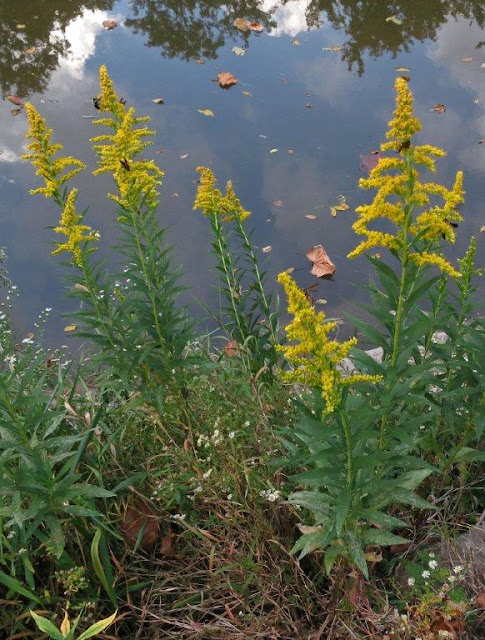Goldenrod is one of our most striking fall wildflowers but
it often gets a bad rap as the cause of hay fever and other allergies. The true
fall allergy culprits are the ragweeds, which have quite inconspicuous flowers.
The reason that ragweeds cause such a problem is that each
plant depends on the wind to distribute its pollen. This is a random process
which requires that the plant use its energy to produce A LOT of pollen in
order to ensure that a few of the microscopic grains fall on a receptive plant
of the same species. Goldenrod, on the other hand, is pollinated by insects,
which is a much more targeted strategy, requires far less pollen, and releases
little or no pollen to the air. It does, however, require the plant to use its
energy to produce flowers that can attract insects via color, shape, aroma, and
nectar. Neither strategy is necessarily
better than the other; they are just different means to the same end.
This fall I’ve put a bit of effort into learning to identify
some of Ohio’s 22 species of goldenrods, and I have a long way to go. The most common species
is the Canada Goldenrod (Solidago canadensis), which turns meadows bright yellow in the fall.
It has a large, triangular plume of flowers at the top of
the flower stalk, and its nectar attracts and feeds myriad insects:
Zigzag Goldenrod (S. flexicaulis) is different in that its blooms occur all
along the stem at the leaf axils. The stem has kind of a zigzag character, but
I think someone could have come up with a better name. The leaves are much
broader than many other goldenrods and they are sharply toothed.
Bog Goldenrod (S. uliginosa), as its name implies, grows in wetlands and marshes. It has a narrow plume of flowers:
Just for fun, here is a curious plant (with a visiting grasshopper) whose common name, Sneezeweed, sounds like it should produce an allergic reaction. Its showy flower, though, would indicate that it is insect pollinated, not wind pollinated. A bit of research shows that its name comes not from pollen-induced sneezing but from the fact that the leaves were at one time used as snuff!










I knew that there were a number of different goldenrod species around here, but I had no idea there were 22. You did a nice job distinguishing between the ones that you presented here. I enjoyed your photos. My favorite being the one with the church, the fall foliage one, and the one with the grasshopper. In the one with the church, I really like how the blue of the sky contrasted with the yellow of the goldenrod.
ReplyDeleteDeb